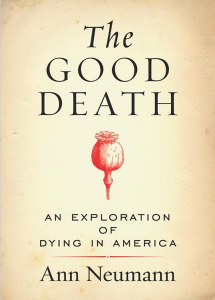Book Review: The Good Death: An Exploration of Dying in America

BOOK BY ANN NEUMANN
BEACON PRESS; 2016
248 PP.; $26.95
With the appearance of The Good Death: An Exploration of Dying in America, author Ann Neumann (a visiting scholar at the Center for Religion and Media at New York University) has produced the book I always wished someone would write. It is intelligent, compassionate, fair, thorough, well-researched, and graceful in both meanings of the word. Before writing this book, Neumann spent a great deal of time with her father in his last illness and with many patients in hospice, volunteering with them throughout their dying process. She emerged with insights on the ways that religion both comforts the dying and makes their struggles more conflicted and less autonomous.
Most of all, Neumann acknowledges that while medical care has added an additional thirty years to the average life span in a century’s time, it has also often made death something we experience only from a distance rather than something that takes place in our homes. She says, “Death has been put off and professionalized to the point where we no longer have to dirty our hands with it.” Even the dying person may be protected from the truth. Most terminal patients are in hospice less than two weeks, hardly long enough to come to terms with the reality. She acknowledges that many don’t “so much make decisions as drift into passive indecision and acquiescence to authority, whether it be that of doctors or nurses or a hospital board.” She also admits that not all hospices are what they should be. Her book is a call for all people to take seriously the one thing we’re all certain to do—die.
The subject of this extraordinary book is heavy, but Neumann sprinkles it with delightful and touching stories of real people facing death (names changed, of course). She understands that this final stage of life can be acceptable, even empowering, if a person is lucky enough to experience “kindness, attention, and friendship of the human heart.” What renders dying terrible is unbearable pain, confusion, and a sense of being abandoned. She advocates strongly for everyone to have the right to say how much suffering he or she is willing to endure.
The reader of this book will learn more about many newsworthy people: Terri Schiavo, Cody Curtis (the woman featured in the documentary How To Die in Oregon), John Rehm, even prisoners at Guantanamo Bay on hunger strikes, inmates on death row, and other prisoners dying of illness or old age. She knows that for-profit healthcare in most prisons causes more suffering than it alleviates. Most books on dying skirt these stories. As well, Neumann helps the reader feel compassion for the disabled activists in Not Dead Yet, a group with whom the World Federation of Right-to-Die Societies and Final Exit Network had very trying experiences at their 2014 conference in Chicago. Virtually everyone in the death with dignity movement will learn from this book and be presented with things they never knew or considered.
Neumann openly admits that the good death may elude us, because
it always hurts, both the dying and the left behind. But there is a good enough death. It is possible to look it in the face, to know how it will come, to accept its inevitability. Knowing death makes facing it bearable. There are many kinds of good enough death, each specific to the person dying. As they wish, as best they can. And there is really one kind of bad death, characterized by the same bad facts: pain, denial, prolongation, loneliness.
